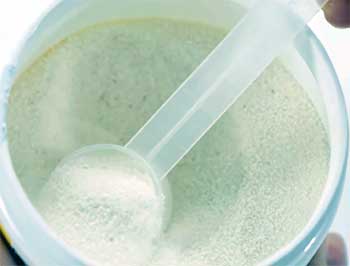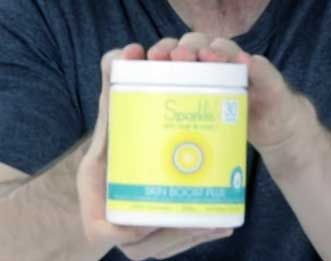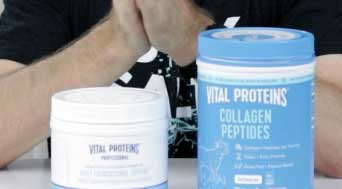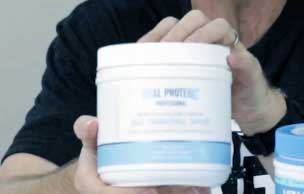When I first started exploring the world of collagen, I was immediately overwhelmed. My skin was losing its “bounce,” and I kept hearing “collagen” as the magic word. But the shelves are packed. You’ve got giant blue tubs of Vital Proteins everywhere, and then you hear whispers in forums about something called “Verisol.”
You’re probably standing in the aisle (or scrolling online) wondering, “What’s the difference, and which one should I actually buy?” I’ve been there, and my goal with this article is to clear up the exact confusion I had, comparing a powerhouse ingredient against a powerhouse brand.
A Brief Comparison Table
| Feature | Verisol (The Ingredient) | Vital Proteins (Original Hydrolyzed Collagen Peptides) |
| Primary Type | Specific Bioactive Collagen Peptides (Types I & III) | Hydrolyzed Collagen Peptides (Types I & III) |
| Primary Source | Bovine, Porcine, or Marine (Varies by product) | Grass-Fed, Pasture-Raised Bovine |
| Key Benefit | Targeted for skin elasticity, wrinkle reduction, and cellulite | General wellness: skin, hair, nails, bones, and joints |
| Recommended Dose | 2.5 grams (2,500 mg) | 10-20 grams (10,000 – 20,000 mg) |
| Clinical Studies | Specific studies on the Verisol peptide blend | General studies on hydrolyzed collagen peptides |
| Protein Per Serving | ~2.3 grams | ~9-18 grams (depending on 1 or 2 scoops) |
| How It’s Sold | As a patented ingredient inside various brands | As a standalone product (the “blue tub”) |
Before we get into the details, I have to clear up the single most confusing part of this comparison. This isn’t a true “brand vs. brand” showdown.
“Verisol” is the brand name for a specific, patented ingredient made by a German company called Gelita.1 It’s a special blend of Bioactive Collagen Peptides (BCPs) that have been optimized to target skin cells.2 Think of it like a specialized tool—a sniper rifle for your wrinkles.
“Vital Proteins” is a massive brand that sells many different collagen products.3 Their most famous product, the one in the blue tub, is simply called “Hydrolyzed Collagen Peptides.” This is a general, high-quality hydrolyzed collagen. Think of this as a “shotgun” approach—it supports skin, hair, nails, and joints and bones.4
So, we’re really comparing a specific, targeted ingredient (Verisol) against a general, all-purpose product (Vital Proteins’ classic powder). To make things even more confusing, Vital Proteins does sell some products (often in their “Professional” or “Skin Hydration” lines) that contain Verisol!5
For this article, I’m focusing on the main matchup: Verisol (as an ingredient) vs. Vital Proteins’ Original Hydrolyzed Collagen Peptides (the blue tub).
My Experience With Both Products

My collagen journey started, like most people’s, with the big blue tub. I bought Vital Proteins Original Collagen Peptides at Costco, attracted by the “grass-fed” label and the promise of… well, everything.
I was in my early 30s and just wanted to be proactive.
I committed to the 20-gram dose every single morning in my coffee. The first thing I noticed, honestly, was the texture change in my coffee.
It was thicker, almost creamier, but not in a way I loved. It took some getting used to. I didn’t see any change for the first month. Or the second. But around the 10-week mark, I was typing, and I suddenly realized my nails were long. I am a notorious nail-biter and peeler, and for the first time, they were strong and actually had white tips. A few weeks after that, I noticed my knees didn’t “click” as much when I did squats. The skin benefits were the last to show up, and they were subtle—just a general “less dry” feeling.
After about a year, I started getting more specific about my goals. My joint “clicks” were gone, but I was really bothered by the “11” lines between my brows and some fine lines around my eyes. I wanted a targeted weapon. That’s when I found a different brand that specifically advertised “Verisol” on the front.
The experience was night and day. The scoop was tiny. It vanished in my coffee with zero taste and zero texture change. I was skeptical. How could this tiny 2.5-gram scoop do what the 20-gram monster scoop couldn’t? I stuck with only the Verisol product for 12 weeks.
The results were different. My nails actually felt a bit weaker again, and I noticed some “creakiness” return to my joints. I had sacrificed the general support. But, around week 8, I looked in the mirror one morning in harsh lighting and was genuinely surprised. My skin looked… plumper. That’s the only word for it. It felt “bouncier” and more hydrated from within. The fine lines around my eyes were visibly softer. It didn’t erase them, but it looked like I’d had a great night’s sleep and a gallon of water.
My conclusion? They are two different tools for two different jobs. Now, my routine is a hybrid. I use a 10-gram scoop (half-dose) of a general hydrolyzed collagen (like Vital Proteins) for my joints and protein, and I add a 2.5-gram scoop of Verisol for the targeted skin benefits. It’s the best of both worlds.
Also read: My Thoughts on Sweet Relief Hair Support
Pros Of Verisol

- Clinically-Backed For Skin: This is Verisol’s entire reason for existing.6 The manufacturer, Gelita, has funded multiple human clinical studies on this specific peptide blend. These studies aren’t just on “collagen” in general; they’re on “Verisol” specifically. The results are impressive, showing statistically significant improvements in skin elasticity, hydration, and a reduction in eye wrinkle volume after just 4 to 8 weeks of use. This is a huge “pro” because you’re buying an ingredient with a track record for the exact purpose you want it for, rather than just hoping a general collagen will work for your skin.
- The Incredibly Low Dose: The standard clinical dose for Verisol is just 2.5 grams (2,500 mg) per day.7 This is, in my opinion, its greatest strength. If you’ve ever tried to choke down a 20-gram dose of collagen (which is two full scoops of Vital Proteins), you know it can be a challenge. It can make your coffee sludgy or your smoothie thick. A tiny 2.5-gram scoop of Verisol is virtually undetectable in any liquid. It’s tasteless, dissolves instantly, and is incredibly easy to maintain as a daily habit. This low-dose efficacy makes compliance a breeze.
- Targeted Action: Verisol is what’s known as a “bioactive” peptide.8 The science here is fascinating. The idea is that these specific, short-chain peptides are absorbed intact and act as signaling molecules. They are recognized by the fibroblast cells in the dermis (the skin’s “factory” cells) and essentially “trick” them into thinking the body’s own collagen is breaking down. This stimulation allegedly ramps up your body’s own production of new collagen and elastin.9 It’s not just “adding” collagen; it’s “stimulating” your skin to rebuild itself.
- Specific Cellulite Claims: This one always turns heads. Verisol is one of the only collagen ingredients on the market with a study specifically targeting the appearance of cellulite. A 2015 double-blind, placebo-controlled study found that a 2.5-gram daily dose of Verisol significantly decreased the “wavy” appearance of cellulite on the thighs of normal-weight and overweight women after 6 months.10 It’s believed to work by strengthening the dermal connective tissue, making it harder for the underlying fat cells to “pucker” the skin’s surface.
- Source Flexibility: Because Verisol is an ingredient used by many different brands, you have options. Gelita produces Verisol from bovine (Verisol B), porcine (Verisol P), and marine (Verisol F) sources.12 While Vital Proteins’ main product is bovine-only, you can find a brand that uses Marine Verisol if you are pescatarian or avoid beef products. This flexibility allows you to align your collagen choice with your dietary preferences without sacrificing the specific, clinically-studied peptide blend.
Cons Of Verisol
- Highly Targeted, Limited Scope: The greatest strength of Verisol is also its main weakness. It was designed, optimized, and studied almost exclusively for skin, hair, and nails.13 If you’re an athlete, have creaky knees, or are looking for joint and bone support, Verisol is not the right tool for the job. Gelita makes other patented peptides for those purposes (like Fortigel for joint cartilage and Fortibone for bone density).14 So, if you buy a Verisol-based product, you are only addressing the beauty aspect, not the comprehensive, full-body support you’d get from a general peptide blend.
- Low Overall Protein: A 2.5-gram serving of Verisol provides about 2.3 grams of protein. This is negligible. Many people, myself included, use their daily collagen scoop (like the 20g dose from Vital Proteins) as a significant protein boost, contributing 18 grams of protein to their daily total. This helps with satiety, muscle repair, and meeting macro goals. You get none of that with Verisol. It is a purely functional, “nutraceutical” ingredient, not a protein supplement in any meaningful way.
- It Can Be Hard To Find: This is a real user-experience issue. You can’t just walk into a store and buy a tub of “Verisol.” You have to buy a product from a brand that uses Verisol. This requires reading labels. You have to look on the ingredient panel for the registered trademark “Verisol®.” This adds a layer of friction to the buying process. You can’t just grab the most popular tub; you have to become a label-reading detective to ensure you’re getting the specific ingredient you’re looking for.
- Potential Cost-Per-Gram: Because it’s a patented, branded, and clinically-studied ingredient, Verisol often carries a premium price. When you buy a 30-day supply of a product containing Verisol, it might look cheaper than a giant tub of Vital Proteins. However, if you break it down by cost-per-gram, Verisol is often significantly more expensive. You’re paying for the research, the specific “peptide fingerprint,” and the brand licensing. You have to decide if that targeted, low-dose convenience is worth the premium price tag.
- Reliance On Third-Party Brands: Your experience with Verisol is entirely dependent on the quality of the brand that sells it. Is the brand reputable? Do they add a bunch of fillers, sugar, or artificial flavors to their powder? Do they third-party test their final product for heavy metals and contaminants? While Verisol itself is a high-quality ingredient, it’s one piece of a larger puzzle. You still have to do your homework on the brand you’re buying it from.
Pros Of Vital Proteins Original Collagen Peptides
- High Dose And High Protein: This is the most obvious “pro.” A full two-scoop serving of Vital Proteins delivers 20 grams of collagen peptides, which translates to 18 grams of pure protein.15 This is a massive dose. For me, this is a fantastic way to front-load my protein intake for the day. I add it to my morning coffee, and I’ve already hit nearly 20 grams of protein before I’ve even eaten breakfast. This is excellent for satiety (feeling full), supporting muscle recovery after a workout, and, of course, providing a large “pool” of amino acids for your body to use.
- Comprehensive, Full-Body Support: Unlike the laser-focused Verisol, Vital Proteins’ blend of Type I and Type III collagen is a general-purpose workhorse. Type I collagen is the most abundant type in our bodies, found in skin, hair, nails, bones, and tendons.16 Type III is found in our skin, muscles, and blood vessels.17 By taking a large 20-gram dose of both, you’re not just targeting your skin; you’re providing the building blocks for your entire connective tissue system. Many long-time users, myself included, often report that the first benefit they notice isn’t in their skin, but in their joints feeling “less creaky” or their nails growing stronger and faster.
- Brand Trust And Transparency: Vital Proteins has built an empire, and they did it by being transparent and accessible. Their products are widely available everywhere, from Costco to local grocery stores. Their sourcing is clear: grass-fed, pasture-raised bovine hide from Brazil.18 Most importantly, their main products are NSF Certified for Sport. This is a huge deal. It means an independent third party has tested the product to verify that what’s on the label is actually in the tub and that it’s free from over 270 banned substances and contaminants. This gives me enormous peace of mind.
- Mixability And Versatility: For such a large scoop, the original unflavored powder is impressively neutral. It dissolves completely in hot liquids like coffee or tea with zero taste.19 I’ll be honest—in cold liquids, it can clump a bit if you don’t use a frother or shaker bottle. But the sheer number of options they offer is a major pro. They have flavored powders (like Chocolate or Vanilla), creamers, stick packs for travel, and even gummies.20 This makes it incredibly easy to find a version of their product that fits your lifestyle.
Cons Of Vital Proteins Original Collagen Peptides

- The Large Serving Size: A 20-gram dose is a lot of powder. We’re talking two large scoops. While it’s “unflavored,” it’s not “nothing.” In plain water, it has a very slight “brothy” taste that some people find off-putting. And in a standard 8-ounce cup of coffee, it will absolutely thicken the texture. It’s not unpalatable, but it’s definitely noticeable. This can be a significant turn-off for people who are sensitive to textures or just want to add something invisibly to their drink. The 2.5-gram Verisol dose is the clear winner here.
- A “Shotgun” Approach: This is the trade-off for getting full-body benefits. You are giving your body 20 grams of general peptides and just… hoping. You’re hoping the right peptides get to your skin, the right ones go to your joints, and so on. It’s not a targeted “signaling” peptide like Verisol. There’s no specific mechanism ensuring it prioritizes wrinkle reduction. It’s general nutritional support. For someone with a specific, stubborn aesthetic concern, this “hope-and-see” approach can feel inefficient and may not yield the targeted results they want.
- Cost Per Tub: That big blue tub is not cheap. While the cost-per-gram might be lower than a Verisol product, the upfront cost is a barrier for many. Dropping $40, $50, or even $70 on a single tub of supplements can be a tough pill to swallow, especially when you’re not even sure it will work for you. This high price point can lead to “sticker shock” and make people hesitant to commit to the long-term use that’s necessary to see results.
- Lacks Specific Clinical Claims: Vital Proteins (and any brand selling general hydrolyzed collagen) can’t legally make the same specific claims as Verisol. They can’t say “reduces eye wrinkles by 20%” or “improves the appearance of cellulite.” They have to stick to general, “structure-function” claims like “supports skin hydration” or “promotes a youthful appearance.” This is because their specific product hasn’t been tested in a clinical trial for those exact outcomes. For a data-driven consumer, the specific, proven claims of Verisol can be much more compelling.
Maintenance Tips For Your Collagen Routine

- Consistency Is The Only Thing That Matters: You cannot take collagen “when you feel like it” and expect results. It doesn’t work that way. This is a cumulative supplement. The peptides need to build up in your system, and your body needs a constant supply to stimulate that fibroblast activity. You must take it every single day. The best way to do this is “habit stacking.” Attach it to something you already do: your morning coffee, your post-workout smoothie, your evening tea. Make it an automatic, non-negotiable part of your day.
- Pair It With Vitamin C: This is the most important “maintenance” tip. Your body cannot synthesize collagen (its own, or from the peptides you eat) without Vitamin C. It’s a non-negotiable co-factor in the process.21 You can take a separate Vitamin C supplement, or you can simply ensure you get it through your diet. A glass of orange juice, a handful of strawberries in your smoothie, or even a squeeze of lemon in your water can be enough. Some collagen powders (like Vital Proteins’ “Advanced” versions) include it in the formula, but it’s always a good idea to be mindful of your intake.
- Patience, Then More Patience: I cannot stress this enough: you will not see results in a week. Or two. Or even three. Clinical studies on Verisol run for 8-12 weeks.22 General collagen studies often run for 6 months to see joint benefits. You are rebuilding your body’s structural matrix from the inside out. This is a slow, methodical process. You must commit to at least 12 weeks before you even think about deciding if it “works” for you. Take a “before” photo in harsh lighting so you have an objective baseline.
- Proper Storage Is Key: These are hydrolyzed powders. “Hydro” means water. They are designed to dissolve in water, which also means they are hygroscopic—they will pull moisture from the air. If you leave the lid loose or store it in a humid environment (like right above your steaming coffee pot), it will turn into a solid, unusable brick. Always seal the tub tightly. Store it in a cool, dry place like a pantry. Never, ever dip a wet spoon into the tub. This will ruin your expensive powder in a hurry.
- Master Your Mixing Technique: Clumps are the number one reason people quit. For hot liquids (coffee, tea, broth), add the powder to your mug first, then pour the hot liquid over it and stir immediately. It will dissolve perfectly. For cold liquids (water, juice, iced tea), you must “bloom” it or use a blender. Add the powder to a small amount of room-temperature water, let it sit for a minute to “bloom” and dissolve, then add the rest of your cold liquid. Or, just use a shaker bottle or a handheld milk frother. A frother is a $10 investment that will make your collagen routine 100% more pleasant.
Read more: My Thoughts on Biogaia Protectis Baby Probiotic Drops
Comparison With Other Brands
- Vital Proteins Vs. Other “Big Box” Brands: When you compare Vital Proteins’ Original powder to its direct competitors like Sports Research or Ancient Nutrition, the differences are subtle. Sports Research is often a bit cheaper and is also IGEN Non-GMO tested and “Informed-Sport” certified, making it a fantastic, high-trust alternative. Ancient Nutrition, co-founded by Dr. Josh Axe, often uses a “Multi-Collagen” approach, combining bovine, chicken, and marine sources to get Types I, II, III, V, and X, which they claim is better for full-body support (especially joints, thanks to Type II). Vital Proteins’ main strength here is its brand recognition and NSF certification, which is the gold standard for many athletes.
- Verisol (The Ingredient) Vs. Other Patented Peptides: Verisol isn’t the only player in the “bioactive peptide” game, not even from its own manufacturer. Gelita also makes Fortigel and Fortibone.23 Fortigel is clinically studied to stimulate cartilage regeneration in the joints, making it the “joint” equivalent of Verisol. Fortibone is studied for improving bone mineral density.24 You’ll see these ingredients in specialized orthopedic or “healthy aging” supplements. This highlights how specific Verisol is—it’s the “beauty” peptide, and these others are for “structure.”
- The “All-In-One” Blends: A huge category of competitors for both of these products are the “all-in-one” beauty powders. Think of brands like Olly Collagen Peptides or Garden of Life Grass-Fed Collagen Beauty. These products take a general hydrolyzed collagen (like Vital Proteins’) and then add other beauty ingredients. They’ll throw in 1000mg of Verisol, plus Biotin, Hyaluronic Acid, and Vitamin C. Their “pro” is convenience—you get everything in one scoop. Their “con” is that you often get a sub-clinical dose of everything. You might only get 10g of collagen and 1.5g of Verisol, not the full dose of either.
- Marine Collagen Brands: For those who don’t consume beef, brands like Further Food or Amandean specialize in wild-caught Marine Collagen. This is almost exclusively Type I collagen and is known for its high bioavailability (it’s absorbed very efficiently). Many users anecdotally report that marine collagen provides the fastest skin benefits. The “con” is that it’s often the most expensive type of collagen and, unless it’s a “Marine Verisol” product, it’s still a “general” peptide, not a targeted one.
Frequently Asked Questions (FAQ)
In their main, popular “blue tub” product (Original Collagen Peptides), no. However, Vital Proteins does use Verisol in some of its other, more specialized products, like those in their “Professional” or “Skin Hydration” lines.25 You must read the specific product’s ingredient label.
No. It’s a “all squares are rectangles, but not all rectangles are squares” situation. Verisol is a type of hydrolyzed collagen, but it’s a specific, patented blend of peptides optimized for a 2.5-gram dose to target skin.26 “Hydrolyzed collagen” is the general term for any collagen broken down into small peptides.27
“Best” is subjective and depends on your goals and values. Vital Proteins is extremely popular due to its high quality and third-party (NSF) testing.28 Other top-tier brands include Sports Research (also third-party tested) and Ancient Nutrition (for multi-collagen blends).
It’s “better” for a specific purpose. If your only goal is to improve skin elasticity and reduce fine lines with a tiny, tasteless dose, the clinical evidence suggests Verisol is superior.29 If you want general, all-over support for skin, hair, nails, and joints plus a protein boost, then a larger dose of a standard hydrolyzed collagen (like Vital Proteins) is “better.”
Conclusion
So, after all that analysis, we’re back to the original question: Which one is better?
As you’ve probably figured out, there is no single “winner.” The better product is the one that’s right for your specific goals, your budget, and your lifestyle.
Here’s how I’ll help you decide, straight from my experience to your screen:
You should choose a Verisol-based product if:
- Your primary concern is your skin: fine lines, elasticity, or even cellulite.
- You want an ingredient with specific clinical studies backing its beauty claims.
- You hate the idea of a thick, sludgy, or high-volume drink and want a tiny, tasteless, low-dose (2.5g) option that disappears in any liquid.
- You already get enough protein and don’t care about joint or bone support.
You should choose Vital Proteins Original Collagen Peptides if:
- You want a “full-body” approach for your skin, hair, nails, and joints.
- You are active and want to support your tendons and ligaments.
- You want a significant protein boost (18g) from your supplement.
- You value brand trust and the peace of mind that comes from rigorous third-party testing (NSF Certified for Sport).
- You don’t mind a larger (20g) scoop that is noticeable in your drink.
For me, the journey led me to use both. But if you’re just starting, I hope this breakdown helps you pick the right tool for the job.
